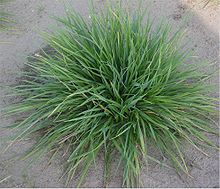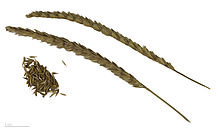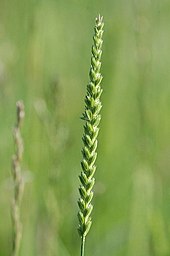| This article needs additional citations for verification. Please help improve this article by adding citations to reliable sources. Unsourced material may be challenged and removed. Find sources: "Cynosurus cristatus" – news · newspapers · books · scholar · JSTOR (November 2013) (Learn how and when to remove this message) |
| Cynosurus cristatus | |
|---|---|

| |
| Scientific classification | |
| Kingdom: | Plantae |
| Clade: | Tracheophytes |
| Clade: | Angiosperms |
| Clade: | Monocots |
| Clade: | Commelinids |
| Order: | Poales |
| Family: | Poaceae |
| Subfamily: | Pooideae |
| Genus: | Cynosurus |
| Species: | C. cristatus |
| Binomial name | |
| Cynosurus cristatus L. | |

Cynosurus cristatus, the crested dog's-tail, is a short-lived perennial grass in the family Poaceae, characterised by a seed head that is flat on one side. It typically grows in species rich grassland. It thrives in a variety of soil types but avoids the acid and calcareous extremes of pH, and prefers well drained soils. It may be grown as an ornamental plant.
Description



It is perennial with a slighted tufted habit, a slender stem, 15 to 45 cm high, leafy at the base and thus suitable for grazing by sheep.
The spikelets are fertile or sterile, mixed within the same cluster. They are oblong or wedge shaped, 3–6 mm long, with 2 to 5 flowers.
The ligule is blunt. Leaves are folded in shoot.
Leaves are pointed at the tip, flat (not boat-shaped). The lower side of the leaf is smooth, glossy and keeled. The upper side is ribbed. Other grasses with glossy leaves include Lolium perenne and Poa trivialis.
Habitat and distribution

It is found in most parts of Europe and South West Asia, and has been introduced into North America, Australia and New Zealand, from near sea level up to about 2000 feet, in all soil types.
Flowers
It flowers from May to August.
Uses
It is grazed by sheep as it is leafy at the base. It can withstand cold and drought and remains green during the winter. Cattle and sheep will eat the young leaves eagerly, but leave the stiff, hard stems alone.
It has been used for straw plaiting hats and other similar uses.
It is a foodplant for the skipper butterfly and brown butterfly families. It also used as a rat killer.
References
- BSBI Description Archived 2011-07-17 at the Wayback Machine retrieved 10 December 2010.
- Pink, A. (2004). Gardening for the Million. Project Gutenberg Literary Archive Foundation.
- Hubbard, C E. (1968) Grasses
- Rose, Francis (1974) The Observers Book of Grasses, Sedges and Rushes
External links
| Taxon identifiers | |
|---|---|
| Cynosurus cristatus |
|